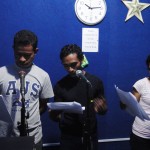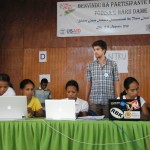SFCG Launches New Country Program in Timor Leste
International Development Program Coordinator Sarah McLaughlin traveled to Timor Leste to see the site of our exciting new country program.
Background
Timor is a small island in Southeast Asia at the east end of the Indonesian chain of islands. Blessed with more than its fair share of natural beauty, it seems almost synonymous with “island paradise.” Yet strife has touched much of the island’s history. It has been politically divided since the Dutch and Portuguese struggled over the island in the 16th century.
The Portuguese claimed the eastern half, East Timor or Timor Leste. Their rule lasted for over 400 years, barring a brief period during WWII when the Japanese occupied the island. Timor declared independence in 1975 but it was short-lived –Indonesia invaded a mere nine days later and remained in power for the next 24 years.
The Indonesian regime took a huge toll on the population: Between 1975 – 1999, nearly 183,000 people died due to killings by the Indonesian military and others from hunger and illness.
A turning point came in 1991, when at least 250 Timorese pro-independence protestors were killed in the Santa Cruz Cemetery by Indonesian troops. British journalist, Christopher Wenner, caught the massacre on tape and was able to smuggle the footage out of the country. The event was also witnessed by two American journalists who later gave testimony on the atrocities committed. The film drew international attention and sympathy for the East Timorese cause. Still it would not be until 2002 that Timor Leste was internationally recognized as an independent nation (the first new sovereign state of the 21st century).
Independence has not been without challenges. The Indonesians leveled many parts of the country before leaving and Timor Leste has struggled with poverty, unemployment and growing conflict between the Easterners (Lorosae) and the Westerners (Loromonu) who claim to have experienced discrimination in the new state. The situation warranted the restoration of the UN Mission in Timor in 2006 and 2008 saw assassination attempts on both the President and Prime Minister.
SFCG in Timor Leste – Youth Radio for Peacebuilding
With a grant from USAID that will fund the project for two years, SFCG’s Radio for Peacebuilding will reach all 13 districts in Timor Leste focusing on young people between 18-29. The programming will include talk shows and drama. The country program will also focus on capacity building and to that end will establish and Youth Radio laboratory, training the next generation of media producers. The country office is located in Dili, the capital and local staff is currently growing.















The journalist who took the footage of the Santa Cruz massacre is British – Max Stahl. The two U.S. journalists were print and radio. They had all their tapes and photos confiscated.
Thanks John, I’ll make the correction.